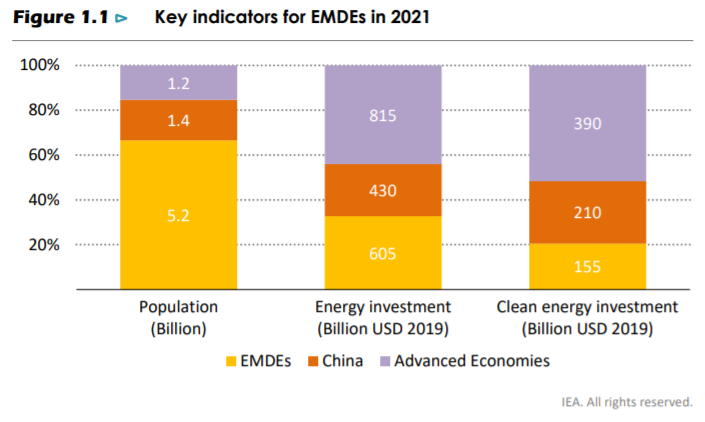- Solar energy blog
- Why investing in developing countries is more beneficial to the environment
Why investing in developing countries is more beneficial to the environment


Laura Rodríguez
Territory Manager Oceania & Nordics
Laura is a renewable and software industry sales professional, currently working at RatedPower as Territory Manager Oceania & Nordics. With a background in International Business and International Trade, Laura previously worked in the business strategy area in various companies as well as as a market analyst for the Government of Spain in Australia.

Content
According to the World Economic Forum, over 70 global chief executives are helping to accelerate the transition to a net-zero economy and at least one-fifth of the world’s largest 2,000 public companies have now committed to meet net-zero targets by mid-century or sooner.
However, this is not enough.
It is known worldwide that to avoid the worst impacts of climate change we need to limit warming to 1.5°C, which will require nearly halving greenhouse gas emissions by 2030 and reaching net-zero by 2050. However, while cities in most developed countries have set clear long-term climate goals such as carbon neutrality by 2050, in many cities in developing regions these targets are usually short-term or mid-term based, which is not entirely compatible with the global climate goals.
A study published by the publisher Frontiers journal which gathers information on greenhouse gas emissions of 167 globally distributed cities has concluded that only 25 of the biggest cities worldwide produce 52% of the total greenhouse gas emissions. Furthermore, while the greenhouse gasses (GHG) emissions per capita is higher in developed countries, developing countries, especially Asian cities emit the most greenhouse gasses.
Are you into renewable trends? You can't miss our report on the solar and renewable energy trends to follow in 2023. Download it today for free!
Transformative policy change and driving investment into developing countries is needed for full decarbonization
Although, governments are starting to react by committing to net-zero or carbon neutrality targets during the next 25-35 years. Net-zero will be impossible unless we invest in developing countries. According to a study carried out by IEA, the World Bank and the World Economic Forum, developing countries account for the majority of future CO2 emissions but only receive a fifth (20%) of clean energy investment.
Developing countries across Asia, Africa and Latin America, already account for ⅔ of the global population and over the next 20 years, their emissions are set to grow by 5 billion tonnes. According to this study, investment would need to increase by 700% until 2030 in these nations for us to have a chance of achieving a net-zero target. ($1 trillion by 2030 to put the world on track to reach net-zero emissions by 2050)

Even though investment in emerging markets is crucial, the truth is that clean energy investment in these countries was half compared to those in advanced economies. Additionally, recent trends in clean energy spending point to a widening gap between advanced economies and the developing world even though emissions reductions are far more cost-effective in the latter.
Avoiding a tonne of CO2 emissions in emerging and developing economies costs about half as much on average as in advanced economies, according to the report.
Investing in developing versus advanced economies
1$ spent in developing countries has a much bigger impact on reducing emissions than in any advanced economies.
There is a simple reasoning behind this concept and it’s the fact that developing economies can often jump directly to cleaner and more efficient technologies as they would have to build the infrastructure from the ground, while developing countries will have to phase out or refit polluting energy projects that are already underway.
However if it’s simpler and cheaper, why isn’t investing growing in these areas?
Emerging markets and developing economies seeking to increase clean energy investment face a range of difficulties, which can undermine risk-adjusted returns for investors and the availability of bankable projects.

These challenges among other project specific factors include:
Availability of commercial arrangements that support predictable revenues for capital-intensive investments
Creditworthiness of counterparties
Availability of enabling infrastructure
Lengthy procedures for licensing and land acquisition
Depleted public finances: debt burdens are on the rise in many economies and few governments in emerging and developing economies have the fiscal space to mobilise resources for a sustainable recovery
Currency instability and weaknesses in local banking and capital markets
Restrictions on foreign direct investment
Poor financial performance of utilities and the country’s energy network
Fortunately, there are many sectors of the economy that directly affect greenhouse emissions. Therefore, to achieve global targets, we must focus on smart investing in these sectors to succeed in bringing down the total emissions.
Most energy intensive cities and economic sectors
The study “Frontiers in Sustainable Cities” shows that only 25 cities out of the 167 studied produce 52% of the greenhouse gas emissions.
Cities only cover 2% of the Earth’s surface, however they are big contributors to the climate crisis and current urban GHG mitigation targets will not be sufficient to achieve global climate change targets by the end of this century.
“Nowadays, more than 50% of the global population resides in cities. Cities are reported to be responsible for more than 70% of GHG emissions, and they share a big responsibility for the decarbonization of the global economy”
Cities in Europe, Australia, and the US had significantly higher per capita emissions than cities in developing areas, however, Asian cities emit the most greenhouse gasses (GHG).

Breaking down the emissions by sector will also give us information on what actions should be prioritized to reduce emissions from buildings, transportation, industrial processes and other sources.
According to the study, stationary energy and transportation were the two main sources of emissions worldwide. Stationary energy – which includes emissions from fuel combustion and electricity use in residential and institutional buildings, commercial buildings, and industrial buildings – contributed between 60 and 80% of total emissions in North American and European cities. On road transportation accounted for more than 30% of total GHG emissions in ⅓ of the cities. Meanwhile, less than 15% of total emissions came from railways, waterways, and aviation.
As for the cities in developing areas, although the emission from transportation could also be considerable given the reliance on fossil fuels, it generally has a lower proportion in total emissions. Industrial development in these markets mainly relies on industries with low technology and high energy consumption.

Driving the change
Major countries have announced ambitious target commitments underpinned by robust policy roadmaps and targets. However, we must ensure that developed countries not only meet their targets, but also fulfil and exceed their $100B commitment to support developing countries mitigate and adapt to climate change.
Unfortunately, the gap of investment in the energy transition between developed and developing countries seems to be getting larger, specifically after Covid-19 outbreak. Additionally, some developed countries have moved high-carbon industries to developing areas (mostly in Asian and Latin American cities) in the past few decades which does not contribute to the set targets.
Not taking mitigating actions against climate change could shrink global GDP by up to 18% in the next 30 years and will be a worldwide climate disaster.
According to United Nations, if worldwide temperature rises +3ºC, there would be a 63% probability of an ice-free Arctic summer in any one year, 41% of mammals would lose their habitat, there would be 10 months average length of drought and a 97% increase in area burned by wildfires in average Mediterranean summer.
Unleashing clean energy investments would bring multiple benefits for society and will help create and protect jobs. As an example, measures to green the production and use of energy could create 18 million additional jobs by 2030, while protecting the current 1.2 billion jobs that rely directly on a healthy and stable environment.
RatedPower has helped design more than 2,000 GW of solar energy in emerging countries and some of the places with the lowest ratio of access to electricity worldwide. Are you interested in knowing more about how RatedPower collaborates in the fight against climate change? Do you wonder how you could do more? Contact us.
Latest stories
Related posts
Market analysis
Power where it’s needed: Solving LatAm’s grid instability with distributed solar and storage
Find out how a bottom-up approach is solving LatAm’s grid instability, with community-led solar and storage projects giving people control over their energy.
Updated 29 DEC, 25

Market analysis
Powering through the peak: Why solar + storage is gaining momentum in MENAT
Discover how MENAT is building a functioning solar economy and why rising peak demand during extreme heat is squeezing its energy architecture.
Updated 11 DEC, 25


Market analysis
The rise of utility-scale PV + storage plants in Italy
Discover how Italy’s latest policies and auctions are driving utility-scale solar and battery storage projects to meet ambitious 2030 targets.
Updated 4 DEC, 25

- RatedPower
- Solar energy blog
- Why investing in developing countries is more beneficial to the environment
 Watch a demo
Watch a demo Ask our AI Product Expert
Ask our AI Product Expert
